15 Landmarks To Visit Before You Turn 65
We All Have Dreams Of Travel Around the World Some day For Once In Our Lifetime. But Very few Get the chance to fulfill it due to many reasons such as Low Income, No Savings, No Time, Not Enough leave from work, Kids’ Holidays, Kids’ Studies Etc, etc. But there are people who have time and money but do not know which country to visit and what We have to look for in that particular country. It Is very important to plan your visit to countries so that you visit all the places not to be missed because we wouldn’t be visiting the same place again
So here We are with the Top 15 landmarks of the world that one should visit before one turns 65. Different countries have different landmarks but we have got you the top 15 which are almost in different countries as well.
As we journey through life, there are certain landmarks that we simply must see before we turn 65. These are the iconic structures that have been built by some of the greatest minds in history, and they offer a glimpse into the past while providing a breathtaking view of the present. From towering monuments to ancient ruins, each of these landmarks has its own story to tell. In this article, we will explore 15 of the world’s most iconic landmarks, discussing who built them, why they were built, their location, and visiting hours and ticket fees. So pack your bags and get ready to embark on a journey of a lifetime as we explore these incredible wonders of the world.
1. Great Wall of China – China
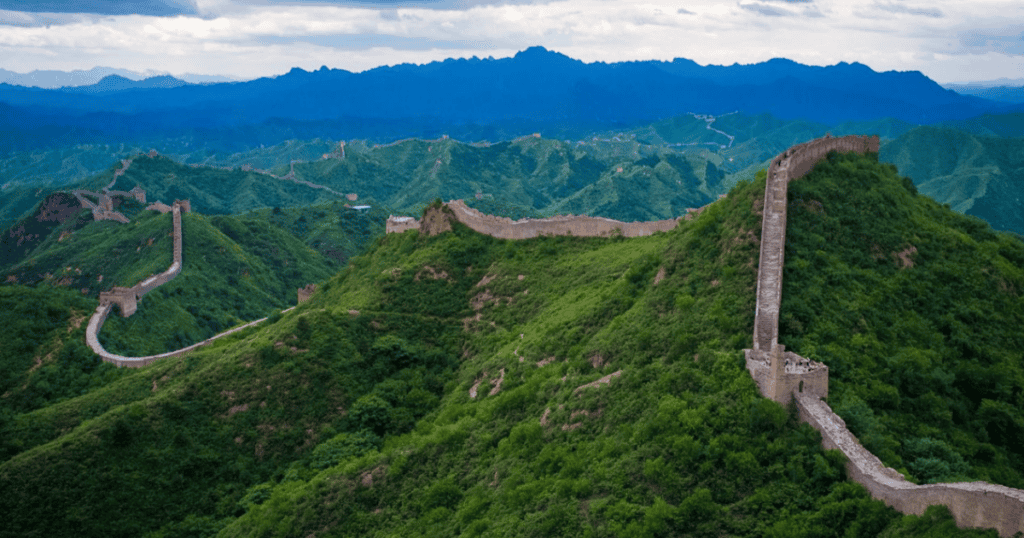
The Great Wall of China is a series of fortifications that were built over centuries, beginning in the 7th century BCE and continuing through the Ming Dynasty (1368-1644 CE). The wall was constructed to protect China’s northern borders from invasions and attacks by various nomadic groups.
The Great Wall of China is a magnificent feat of engineering and a symbol of China’s rich history and culture. However, the wall is facing many challenges today, such as natural erosion, human damage, and climate change. To preserve this iconic landmark and keep it in its natural form, the Chinese government has launched several initiatives.
Firstly, the government has established a comprehensive monitoring system to regularly inspect the condition of the wall. This system includes physical inspections, satellite imaging, and drone surveillance. Any damage or erosion detected is quickly addressed, and restoration work is carried out to ensure that the wall remains in good condition.
Secondly, the Chinese government has implemented strict regulations and penalties to deter people from damaging the wall. Visitors are not allowed to climb or walk on the wall in certain sections, and there are designated paths and walkways to ensure that the wall is not damaged by foot traffic. Additionally, there are surveillance cameras and security guards to prevent any unauthorized activities.
Thirdly, the government has launched several public awareness campaigns to educate people about the importance of preserving the wall. These campaigns encourage people to respect the wall’s natural form and to take responsibility for its preservation.
Overall, the Chinese government’s efforts to preserve the Great Wall of China are commendable. By implementing measures to monitor and protect the wall, the government is ensuring that this iconic landmark will continue to inspire awe and wonder for generations to come.
Who built it?
Various Chinese dynasties, including the Qin, Han, and Ming Dynasties, were responsible for building different sections of the wall. The wall was also constructed by millions of laborers, including soldiers, peasants, and prisoners of war.
Read More About China on our dedicated post – Journey Through China: A Traveler’s Guide to the Land of Ancient Wonders
Why was it built?
The Great Wall was built as a military fortification to protect China’s borders from invading armies. It was also used for border control, allowing China to regulate trade and immigration.
Location:
The Great Wall of China stretches across northern China and covers over 13,000 miles. It spans several provinces and regions, including Liaoning, Hebei, Beijing, Tianjin, Shanxi, Inner Mongolia, Shaanxi, Ningxia, and Gansu.
Visiting Hours and Ticket Fees:
The Great Wall of China is open to visitors year-round, but the hours of operation vary depending on the section of the wall you visit. The most popular sections, such as Badaling and Mutianyu, are typically open from 7:30 AM to 4:30 PM. The ticket prices also vary depending on the section you visit, but they generally range from 40 to 80 Chinese yuan (approximately $6 to $12 USD). Some sections of the wall, such as Jiankou and Gubeikou, are free to visit, but they are also more difficult to access and may require a local guide.
2. Taj Mahal – India
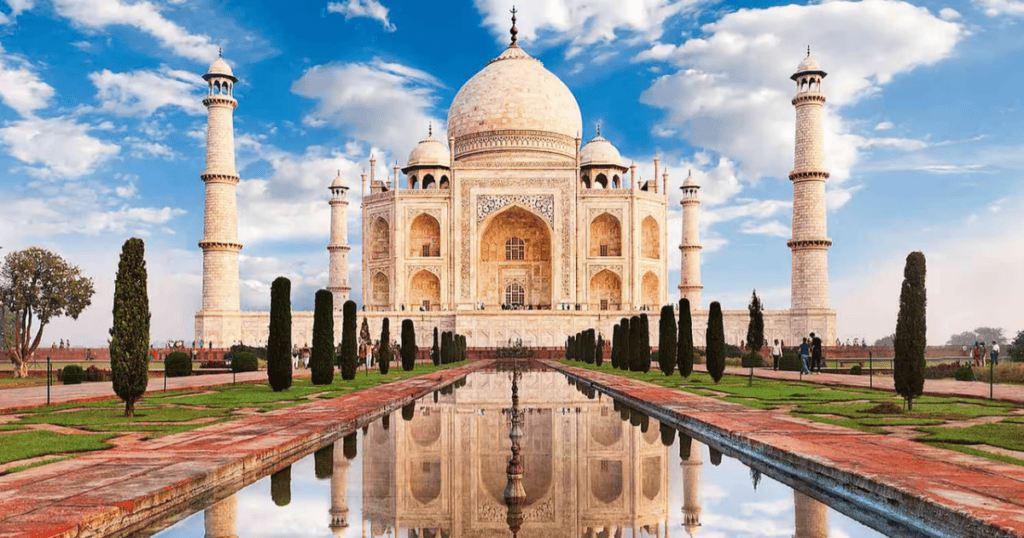
The Taj Mahal is a white marble mausoleum located in the city of Agra, India. It was built in the 17th century by the Mughal emperor Shah Jahan as a monument to his beloved wife Mumtaz Mahal, who died while giving birth to their 14th child.
Read More about the Culture, History, and Diversity of India on Discovering the Wonders of India
Who built it?
The Taj Mahal was built by the Mughal emperor Shah Jahan, who ruled India from 1628 to 1658. He commissioned the construction of the Taj Mahal as a final resting place for his wife Mumtaz Mahal, who died in 1631.
Why was it built?
Shah Jahan was grief-stricken by the death of his wife Mumtaz Mahal, and he wanted to create a grand monument to honor her memory. The Taj Mahal was designed as a symbol of love and devotion, and it is considered one of the finest examples of Mughal architecture.
Location:
The Taj Mahal is located in the city of Agra, in the northern Indian state of Uttar Pradesh. Agra was the capital of the Mughal Empire in the 17th century, and it is home to several other historic landmarks, including the Agra Fort and the Fatehpur Sikri.
Visiting Hours and Ticket Fees:
The Taj Mahal is open to visitors from sunrise to sunset, except on Fridays when it is closed for prayers. The entrance fee for foreign visitors is 1300 Indian rupees (approximately $18 USD), while Indian citizens pay a reduced fee of 50 rupees (approximately $0.70 USD). Visitors can also purchase tickets online in advance to avoid long queues at the ticket counter.
3. Statue of Liberty – United States
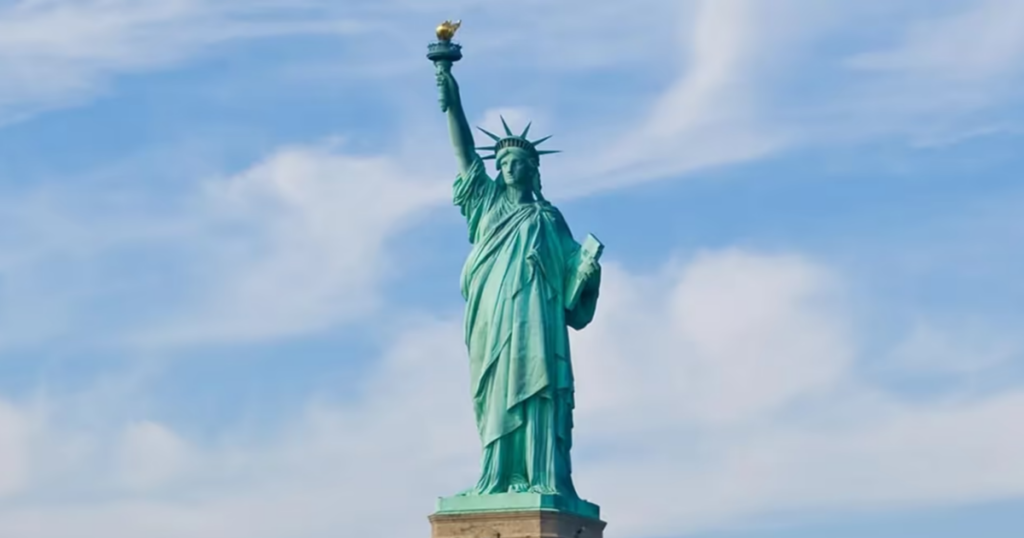
The Statue of Liberty is a colossal neoclassical sculpture located on Liberty Island in New York Harbor, United States. It was a gift from the people of France to the people of the United States, and it has become a symbol of freedom and democracy around the world.
The Statue of Liberty is an iconic symbol of freedom and democracy, located on Liberty Island in New York Harbor. As one of the most recognizable landmarks in the world, the Statue of Liberty draws millions of visitors every year, who come to marvel at its beauty and learn about its rich history.
However, the statue, like many other monuments and landmarks, is subject to natural wear and tear and requires constant upkeep to maintain its beauty and structural integrity. The US government has taken several measures to ensure the preservation of the statue and keep it in its natural form.
For instance, the National Park Service, which is responsible for managing and maintaining the Statue of Liberty National Monument, conducts regular inspections to identify any potential damage or issues. Additionally, they have implemented a number of conservation projects, such as repairing and replacing damaged stone, cleaning the statue’s surface, and installing new lighting systems.
Furthermore, the government has taken steps to address the effects of climate change on the statue and its surrounding environment. Rising sea levels and extreme weather events pose a threat to the statue and the island, and the government has implemented measures to protect against erosion and flooding.
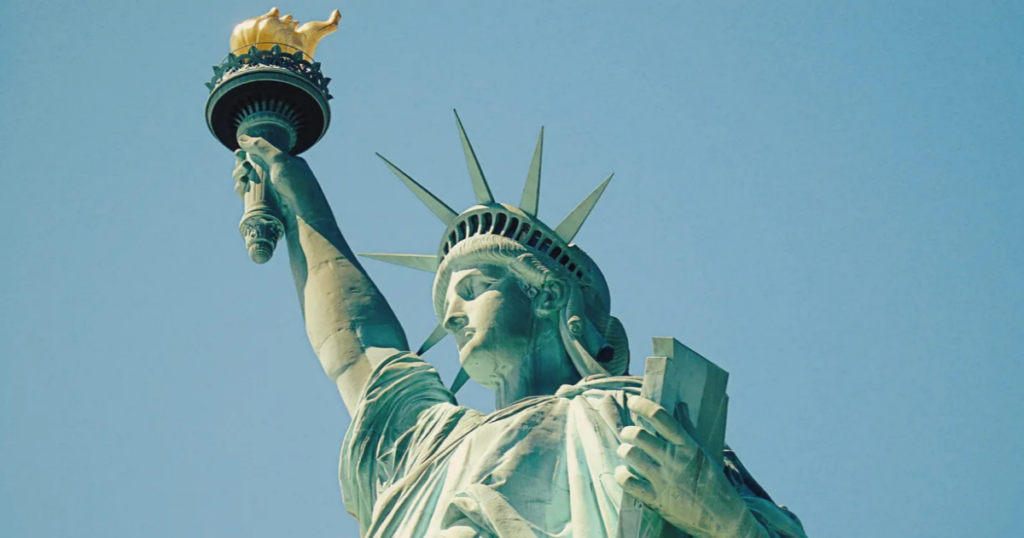
Read More About The USA on Exploring the Best of America: A Guide to Must-Visit Tourist Destinations in the USA
Who built it?
The Statue of Liberty was designed by French sculptor Frédéric Auguste Bartholdi and was constructed with the assistance of engineer Gustave Eiffel, who is also known for designing the Eiffel Tower in Paris. The pedestal for the statue was designed by American architect Richard Morris Hunt.
Why was it built?
The Statue of Liberty was built to commemorate the centennial of the American Declaration of Independence and to celebrate the friendship between France and the United States. The statue was also intended to serve as a symbol of freedom and democracy, particularly for immigrants who were arriving in the United States in large numbers at the time.
Location:
The Statue of Liberty is located on Liberty Island, which is situated in New York Harbor. The island is also home to the Ellis Island National Museum of Immigration, which tells the story of the millions of immigrants who passed through Ellis Island on their way to a new life in the United States.
Visiting Hours and Ticket Fees:
The Statue of Liberty is open to visitors year-round, but the hours of operation vary depending on the season. The statue is typically open from 9:00 AM to 5:00 PM, and visitors can access the pedestal and crown with advance reservations. The cost of tickets varies depending on the type of access requested, but general admission tickets start at $25 USD for adults and $16 USD for children. Visitors can also purchase tickets that include a ferry ride to Liberty Island and Ellis Island.
Follow us on Youtube
Follow us on Facebook
Follow us on Twitter
Follow us on Instagram
4. Eiffel Tower – France
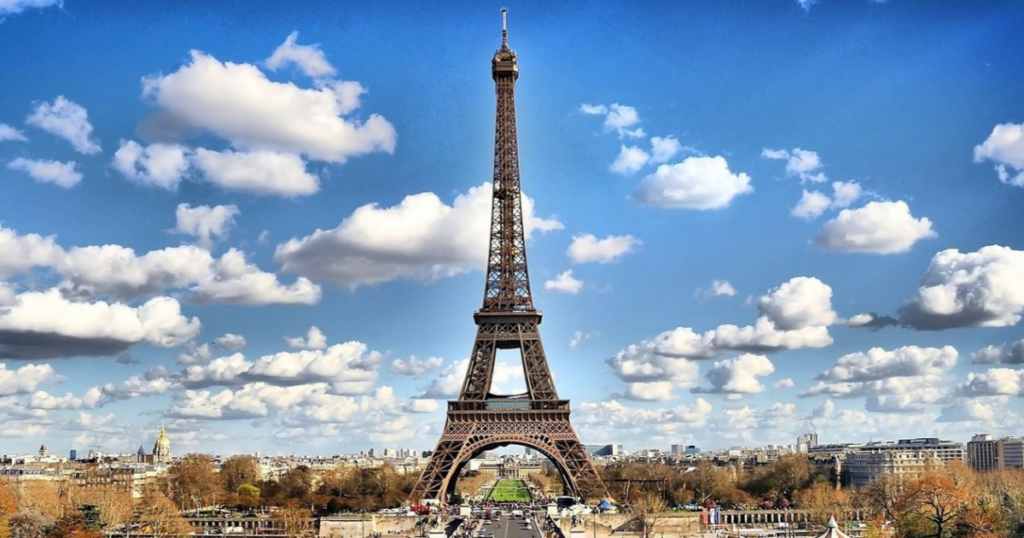
The Eiffel Tower is an iron lattice tower located on the Champ de Mars in Paris, France. It was built for the 1889 Exposition Universelle (World’s Fair) and has since become one of the most recognizable landmarks in the world.
One of the primary ways that France has preserved the Eiffel Tower is through regular maintenance and restoration work. The tower undergoes a thorough cleaning every seven years to remove dirt, rust, and grime that can accumulate over time. In addition, the tower’s iron structure is inspected regularly to ensure that it remains stable and safe for visitors.
France has also taken steps to modernize the Eiffel Tower while still preserving its historical character. In 2013, the tower underwent a major renovation that included the installation of energy-efficient LED lighting, which reduced the tower’s electricity consumption by over 30%. The new lighting system also allows for the tower to be lit up in a variety of colors, providing a stunning visual display that can be seen from miles away.
Another way that France has preserved the Eiffel Tower is by limiting the number of visitors to the tower at any given time. In 2018, the French government introduced a new system that requires visitors to book their tickets in advance, with only a limited number of tickets available each day. This measure helps to reduce overcrowding on the tower and protect the tower’s structure from damage caused by heavy foot traffic.
In conclusion, the Eiffel Tower is an important part of France’s cultural heritage, and the country has taken various measures to ensure that it remains in its original form. From regular maintenance and restoration work to modernization efforts and visitor management systems, France is committed to preserving the beauty and history of this iconic landmark for generations to come.
Read More About Country France On Beyond the Eiffel Tower: Exploring France’s Hidden Gems
Who built it?
The Eiffel Tower was designed by French engineer Gustave Eiffel, who also helped design the internal structure of the Statue of Liberty in New York. Eiffel’s company, Compagnie des Établissements Eiffel, was responsible for the construction of the tower.
Why was it built?
The Eiffel Tower was built as the centerpiece of the 1889 Exposition Universelle, which celebrated the 100th anniversary of the French Revolution. The tower was intended to showcase France’s industrial prowess and engineering excellence, and it was seen as a symbol of modernity and progress.
Location:
The Eiffel Tower is located in the city of Paris, in the Île-de-France region of France. The tower is situated on the Champ de Mars, a large public park in the 7th arrondissement of Paris. The tower is visible from many parts of the city, and it is often featured in postcards and travel brochures as a symbol of Paris.
Visiting Hours and Ticket Fees:
The Eiffel Tower is open to visitors year-round, but the hours of operation vary depending on the season. The tower is typically open from 9:30 AM to 11:45 PM, and visitors can purchase tickets online in advance to avoid long queues at the ticket counter. The cost of tickets varies depending on the type of access requested, but general admission tickets start at €10.40 (approximately $12 USD) for adults and €5.20 (approximately $6 USD) for children. Visitors can also purchase tickets that include access to the tower’s upper levels, including the observation deck and restaurants.
5. Great Pyramid of Giza – Egypt
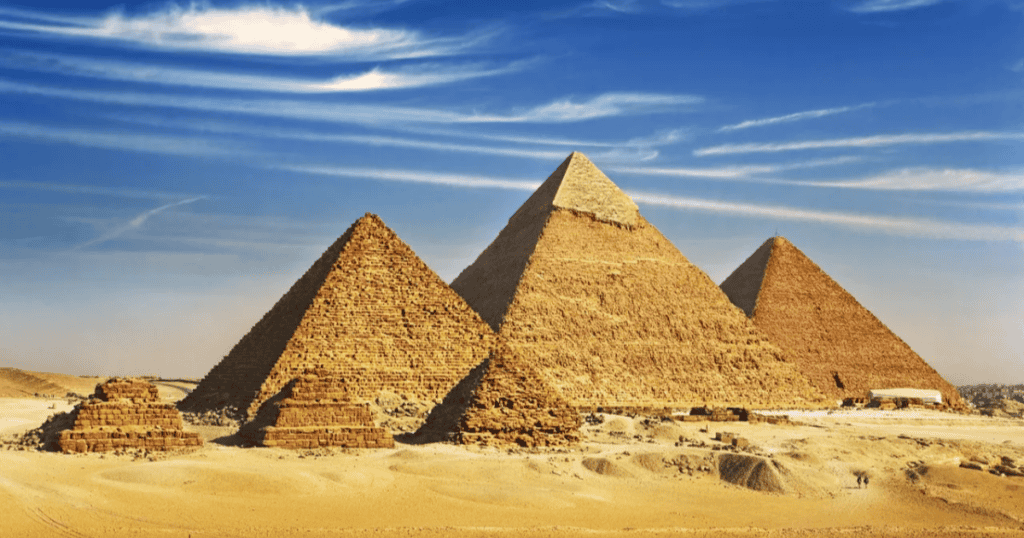
The Great Pyramid of Giza, also known as the Pyramid of Khufu or the Pyramid of Cheops, is the oldest and largest of the three pyramids in the Giza pyramid complex. It was built over 4,500 years ago as a tomb for the Pharaoh Khufu and is considered one of the Seven Wonders of the Ancient World.
Who built it?
The Great Pyramid of Giza was built during the reign of the Pharaoh Khufu, who ruled from 2589 to 2566 BC. It is believed that the pyramid was constructed by a workforce of around 100,000 laborers who worked on the site for over 20 years. The exact methods used to build the pyramid are still a mystery, but it is thought that the workers used a combination of ramps, sledges, and pulleys to transport the massive limestone blocks into place.
Why was it built?
The Great Pyramid of Giza was built as a tomb for the Pharaoh Khufu, who was the second ruler of the Fourth Dynasty of Egypt. The pyramid was designed to protect Khufu’s body and his treasures in the afterlife, and it was intended to serve as a monument to his power and prestige as a ruler.
Location:
The Great Pyramid of Giza is located on the Giza plateau, just outside the city of Cairo in Egypt. The pyramid complex includes three pyramids, the largest of which is the Great Pyramid of Giza, along with several smaller pyramids, temples, and tombs. The Giza plateau is situated on the west bank of the Nile River, and the pyramids are visible from miles away.
Visiting Hours and Ticket Fees:
The Great Pyramid of Giza is open to visitors year-round, but the hours of operation vary depending on the season. Visitors can purchase tickets at the entrance to the pyramid complex, and tickets are required to enter the pyramids and other sites within the complex. The cost of tickets varies depending on the sites visited and whether visitors choose to enter the pyramids. As of 2021, the cost for general admission to the Giza complex, which includes access to the Sphinx and other sites, is 200 Egyptian pounds (approximately $13 USD) for foreigners. Additional fees apply for entrance to the pyramids and other special areas.
Follow Us for more on Instagram
6. Golden Gate Bridge – United States
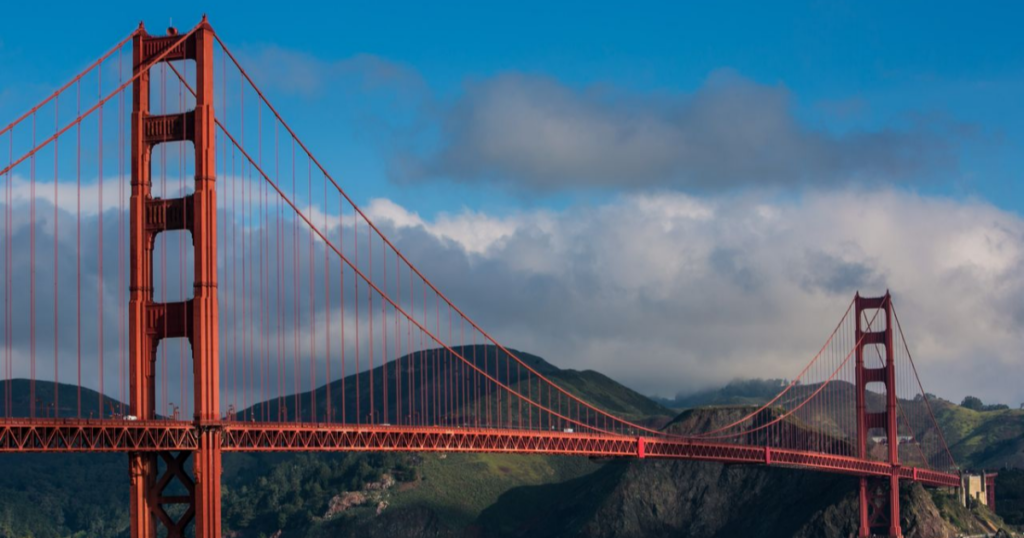
The Golden Gate Bridge is a suspension bridge that spans the Golden Gate strait, connecting San Francisco to Marin County in California, USA. It is considered an engineering marvel and an iconic symbol of San Francisco, attracting millions of visitors each year.
Read More About The USA on Exploring the Best of America: A Guide to Must-Visit Tourist Destinations in the USA
Who built it?
The Golden Gate Bridge was designed by Joseph Strauss, Irving Morrow, and Charles Ellis, and construction began in 1933. The bridge was built by a team of thousands of workers, including ironworkers, electricians, and painters. Many of the workers were immigrants from Europe and Asia who had come to the United States looking for work during the Great Depression.
Why was it built?
The Golden Gate Bridge was built to provide a transportation link between San Francisco and Marin County, which had previously only been accessible by ferry. The idea for the bridge had been proposed as early as the 19th century, but it wasn’t until the 1920s and 1930s that plans for the bridge began to take shape. The project was also seen as a way to boost the economy and provide jobs during the Great Depression.
Location:
The Golden Gate Bridge spans the Golden Gate strait, which connects San Francisco Bay to the Pacific Ocean. It is located in San Francisco, California, USA, and stretches 1.7 miles (2.7 km) across the strait. The bridge is situated in the Golden Gate National Recreation Area, which is a popular destination for hiking, biking, and sightseeing.
Visiting Hours and Ticket Fees:
The Golden Gate Bridge is open to pedestrians, cyclists, and cars year-round, 24 hours a day. There is no admission fee to cross the bridge, but there is a toll for vehicles traveling from San Francisco to Marin County. Visitors can access the bridge by car, bike, or on foot, and there are several parking lots and viewpoints along the bridge for sightseeing and photography. The bridge can also be accessed by public transportation, including buses and ferries.
7. Colosseum – Italy
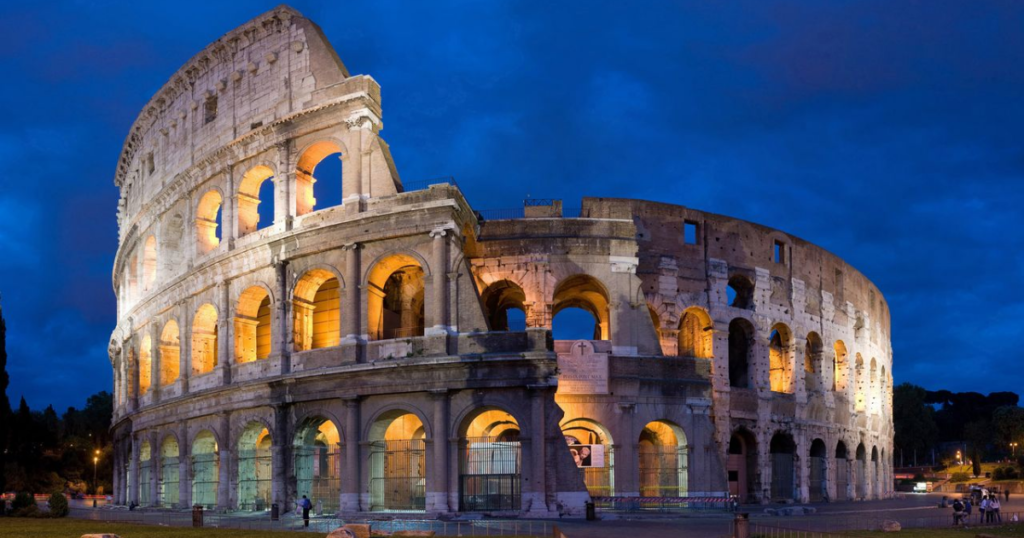
The Colosseum, also known as the Flavian Amphitheatre, is an ancient Roman arena located in the heart of Rome, Italy. It is one of the most iconic landmarks in the city and a popular destination for tourists from all over the world.
Who built it?
The Colosseum was built during the Flavian dynasty, under the reigns of emperors Vespasian and Titus. Construction began in AD 72 and was completed in AD 80. The architects who designed the Colosseum are unknown, but it is believed that many skilled artisans and engineers were involved in its construction.
Why was it built?
The Colosseum was built as an arena for gladiatorial contests and other public spectacles, such as animal hunts and mock sea battles. It could seat up to 80,000 spectators and was used for over four centuries. The Colosseum was also used for other purposes over the years, such as religious processions and as a fortress during medieval times.
Location:
The Colosseum is located in the center of Rome, Italy, in the Piazza del Colosseo. It is situated in the Monti district, just east of the Roman Forum and Palatine Hill. The Colosseum is easily accessible by public transportation, including buses and the metro.
Visiting Hours and Ticket Fees:
The Colosseum is open to visitors year-round, with varying hours depending on the season. Admission fees vary depending on the type of ticket purchased and whether visitors choose to purchase a combined ticket for other nearby attractions such as the Roman Forum and Palatine Hill. Tickets can be purchased in advance online or on site, but it is recommended to purchase tickets in advance to avoid long lines. Audio guides and guided tours are also available for an additional fee.
The tickets can be purchased from – https://romecolosseumtickets.tours/colosseum-tickets-rome-skip-the-line/
8. Sydney Opera House – Australia
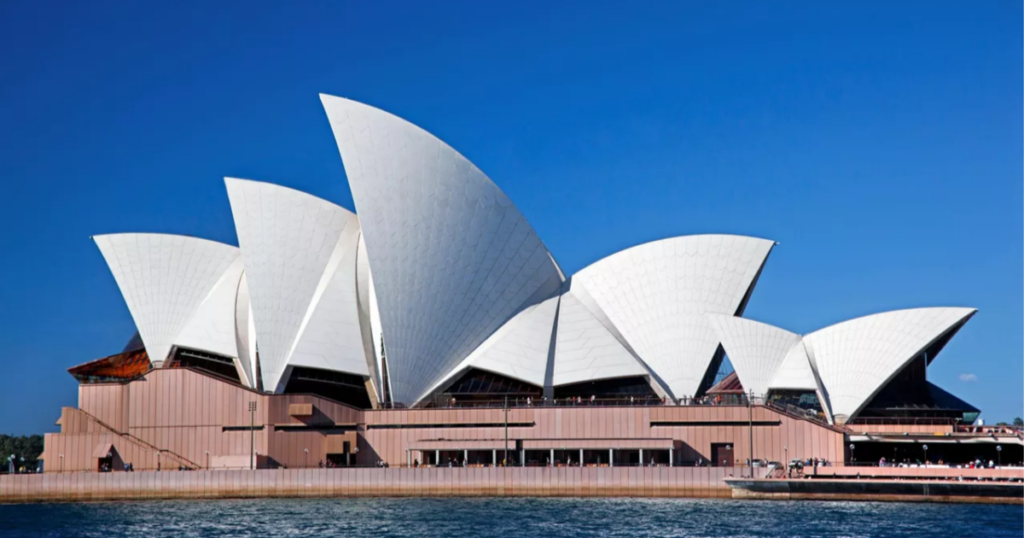
The Sydney Opera House is a multi-venue performing arts center located on Sydney Harbour in Sydney, Australia. It is one of the most recognizable landmarks in Australia and a UNESCO World Heritage Site.
Who built it?
The Sydney Opera House was designed by Danish architect Jørn Utzon and built by a team of Australian architects, engineers, and construction workers. Construction began in 1959 and was completed in 1973, over a decade later than originally planned due to design and construction challenges.
Why was it built?
The Sydney Opera House was built to serve as a home for the performing arts in Sydney, and to provide a space for cultural events and performances. It was envisioned as a world-class venue that would attract performers and audiences from around the globe.
Location:
The Sydney Opera House is located on Bennelong Point, on the edge of Sydney Harbour in Sydney, Australia. It is situated in the central business district and is easily accessible by public transportation, including buses, trains, and ferries.
Visiting Hours and Ticket Fees:
The Sydney Opera House is open to visitors year-round, with varying hours depending on the season and scheduled performances. Guided tours are available, as well as backstage tours that offer a behind-the-scenes look at the workings of the venue. Admission fees vary depending on the type of tour and whether visitors choose to attend a performance or not. Tickets can be purchased in advance online or on site. It is recommended to book tickets well in advance for popular shows or tours.
9. Big Ben – United Kingdom

Big Ben is the nickname for the Great Bell of the clock at the north end of the Palace of Westminster in London, United Kingdom. The clock tower is officially known as Elizabeth Tower and is one of the most iconic symbols of London.
Who built it?
The clock tower was designed by architect Augustus Pugin and completed in 1859. The clock mechanism was designed by clockmaker Edward John Dent, and the Great Bell was cast by the Whitechapel Bell Foundry.
Why was it built?
The clock tower was built to house a bell that would strike on the hour and serve as a timekeeping device for the Palace of Westminster, the seat of the British Parliament. The tower was also designed to be a prominent symbol of the power and authority of the British government.
Location:
The Elizabeth Tower, or Big Ben, is located at the north end of the Palace of Westminster in London, England. The Palace of Westminster is situated on the north bank of the River Thames and is easily accessible by public transportation, including buses, trains, and the London Underground.
Visiting Hours and Ticket Fees:
Due to ongoing renovations, access to the Elizabeth Tower and the Great Bell is currently restricted to UK residents with tickets booked through their Member of Parliament or a tour operator. However, visitors can still view the tower and the Great Clock from the outside, and guided tours of the Palace of Westminster are available. Admission fees for guided tours vary depending on the tour and can be booked in advance online or through the Houses of Parliament Visitor Services.
10. Burj Khalifa – United Arab Emirates
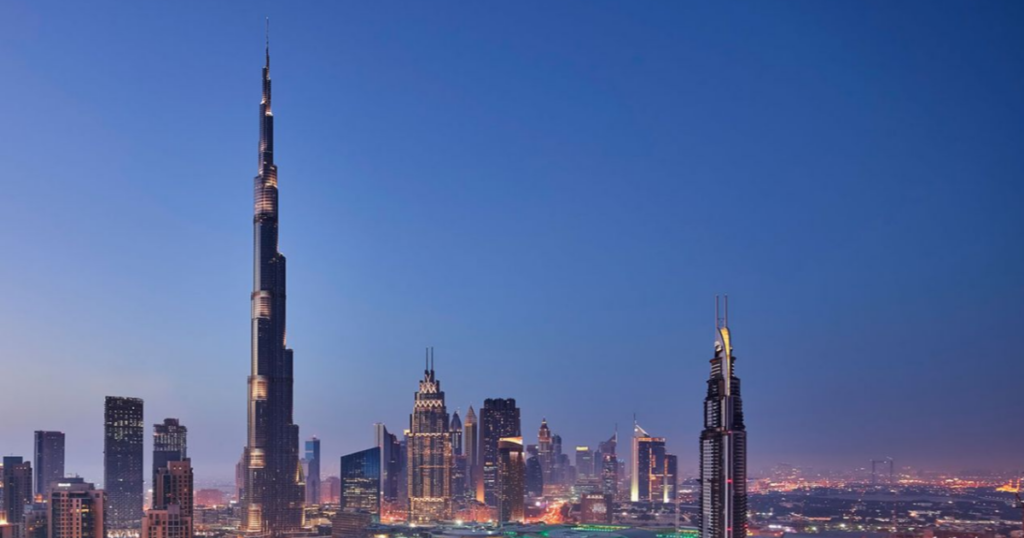
Burj Khalifa is the tallest building in the world, located in Dubai, United Arab Emirates. The tower is a modern architectural marvel that has become a symbol of the city and the UAE as a whole.
Who built it?
Burj Khalifa was designed by the Chicago-based architectural firm Skidmore, Owings & Merrill and was constructed by South Korean conglomerate Samsung C&T. The tower was officially opened in January 2010, after six years of construction.
Why was it built?
The tower was built as part of a larger project to revitalize the downtown area of Dubai and to establish the city as a global hub for business, tourism, and entertainment. The tower also serves as a testament to the ambition and engineering prowess of the UAE.
Location:
Burj Khalifa is located in the city of Dubai, United Arab Emirates. The tower is situated in the downtown area of the city, adjacent to the Dubai Mall, the largest shopping mall in the world. The tower can be easily accessed by car, taxi, or public transportation, including the Dubai Metro.
Visiting Hours and Ticket Fees:
Burj Khalifa offers visitors the opportunity to experience the tower’s observation deck, known as At The Top, which provides stunning views of the city and the surrounding area. The observation deck is located on the 124th floor of the tower and can be accessed through the Dubai Mall. Tickets for At The Top can be purchased online in advance or on-site at the ticket counter, with prices varying depending on the time of day and the type of ticket purchased. The tower is open to visitors daily from 9am to 11pm, with extended hours on weekends and holidays.
11. Machu Picchu – Peru
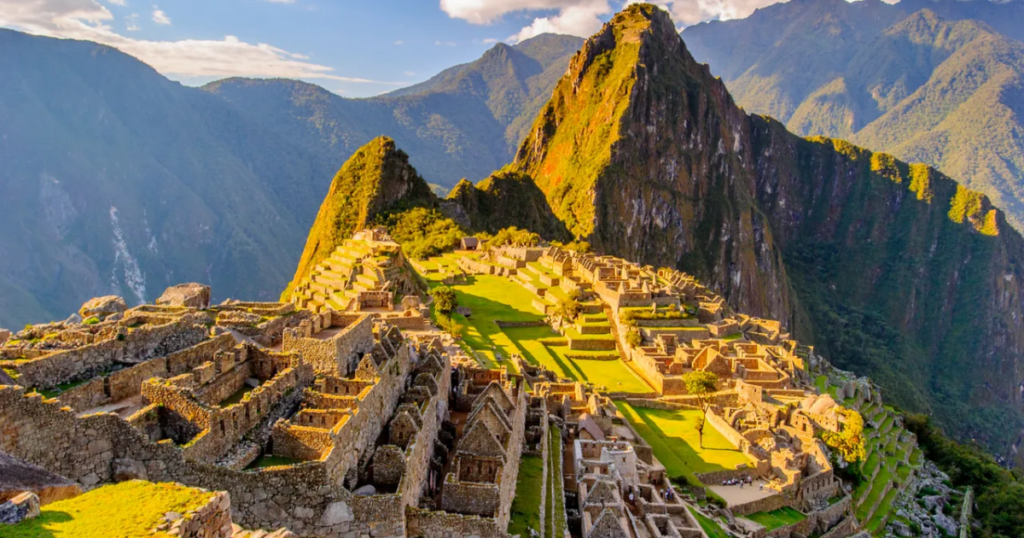
Machu Picchu is an ancient Incan city located in the Andes Mountains of Peru. It is considered one of the most impressive archaeological sites in the world, and was declared a UNESCO World Heritage Site in 1983.
Who built it?
Machu Picchu was built in the 15th century by the Incas, an indigenous civilization that lived in the Andes region of South America. The city was abandoned in the 16th century, and remained hidden from the outside world until it was rediscovered by archaeologist Hiram Bingham in 1911.
Why was it built?
The exact purpose of Machu Picchu remains a mystery, but it is believed to have served as a royal estate or religious site for the Incan emperor. The city is known for its impressive architecture, which features intricate stone masonry and engineering that allowed it to withstand earthquakes and other natural disasters.
Visiting Hours and Ticket Fees:
Machu Picchu is located in the Cusco Region of Peru, approximately 50 miles northwest of the city of Cusco. The city is situated on a mountain ridge above the Sacred Valley, and can only be accessed by train or on foot via the Inca Trail.
Location:
Machu Picchu is open to visitors daily from 6am to 5:30pm, with limited capacity due to conservation efforts. Tickets must be purchased in advance, and visitors are encouraged to book their tickets well in advance due to high demand. There are several types of tickets available, including options for guided tours and access to additional hiking trails within the park.
12. Moscow Kremlin – Russia
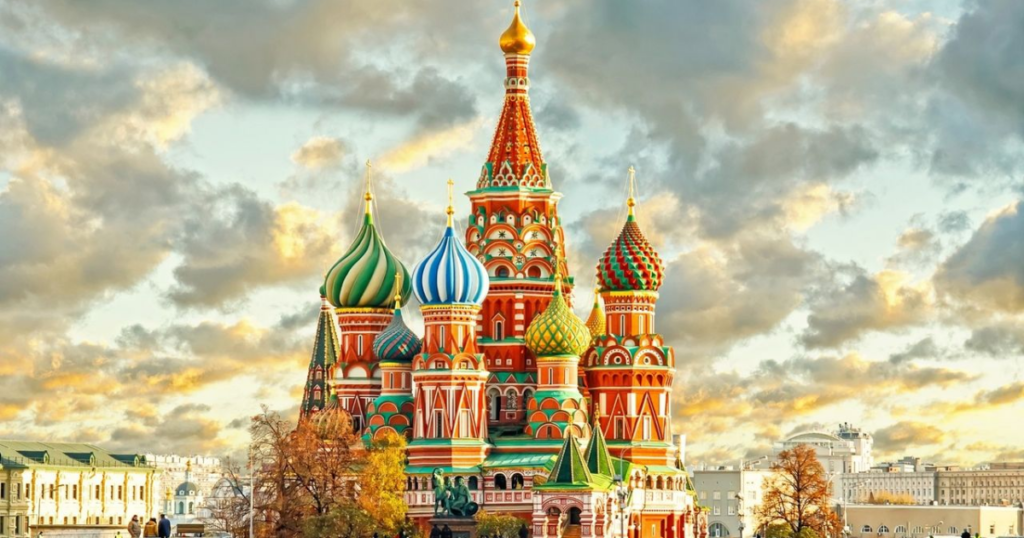
The Moscow Kremlin is a historic fortress located in the heart of Moscow, Russia. It is home to several museums and government buildings, including the official residence of the President of Russia. The complex is surrounded by a wall with 20 towers and includes several cathedrals, palaces, and museums.
Who built it?
The Moscow Kremlin was originally built in the 12th century as a wooden fortification to protect the city of Moscow from invaders. Over the centuries, it was rebuilt and expanded with new structures and walls made of brick and stone. The most notable structures were built during the reigns of Ivan the Great and Ivan the Terrible in the 15th and 16th centuries.
Why was it built?
The Moscow Kremlin was built as a defensive structure to protect the city of Moscow from invaders. It served as the seat of power for the Russian government for many centuries, and was also a symbol of the country’s military and political strength.
Location:
The Moscow Kremlin is located in the heart of Moscow, Russia, on the banks of the Moskva River. It is situated within the Garden Ring, a major ring road that circles the central part of the city.
Visiting Hours and Ticket Fees:
The Moscow Kremlin is open to visitors daily from 10am to 5pm, with extended hours in the summer months. Tickets must be purchased in advance, and visitors are required to go through security checks before entering the complex. There are several ticket options available, including access to the museums, cathedrals, and palaces within the complex. Guided tours are also available for an additional fee.
13. Leaning Tower of Pisa – Italy
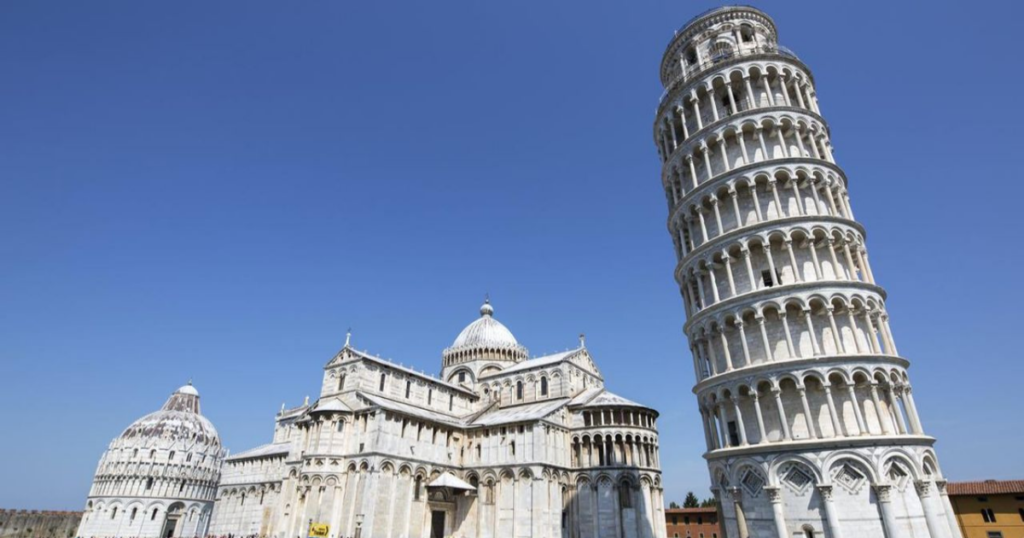
The Leaning Tower of Pisa is one of the most recognizable buildings in the world due to its distinctive tilt. Despite its unintended tilt, it is still considered an architectural marvel and attracts millions of visitors each year. The Leaning Tower of Pisa is a famous bell tower located in the Italian city of Pisa. Here are some details about this iconic landmark.
Who built it?
The tower was built by Bonanno Pisano, who was the chief architect of the cathedral in Pisa. The construction of the tower began in 1173 and took around 200 years to complete.
Why was it built?
The tower was built as a bell tower for the nearby cathedral. However, the tower’s tilt began during construction due to the soft ground on one side of the tower’s foundation, which caused the tower to sink.
Location:
The Leaning Tower of Pisa is located in the city of Pisa, which is situated in the Tuscany region of Italy.
Visiting Hours and Ticket Fees:
The tower is open to visitors year-round, and visiting hours vary depending on the season. Ticket fees also vary, with discounts available for children, students, and seniors. Visitors can also purchase tickets that include access to other nearby attractions, such as the Pisa Cathedral and Baptistery.
14. Plaza de España – Spain
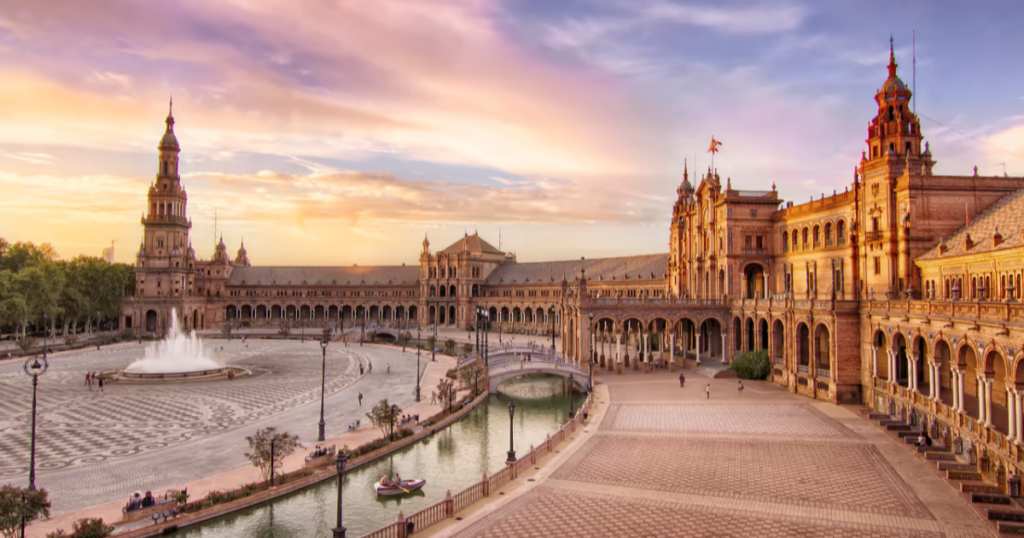
Plaza de España is a beautiful square located in the city of Seville, Spain. The square was built for the Ibero-American Exposition of 1929, which was a world’s fair held in Seville to showcase the country’s cultural and economic achievements.
Who built it?
The square was designed by the Spanish architect Aníbal González. It is a beautiful example of the Renaissance Revival architectural style that was popular during the early 20th century.
Why was it built?
The Plaza de España was built to showcase Spain’s culture and history during the Ibero-American Exposition of 1929. It was also meant to serve as a symbol of Spain’s renewed interest in its own culture and heritage after a period of political and social upheaval.
Location:
Plaza de España is located in the city of Seville, which is the capital and largest city of the southern Spanish region of Andalusia. Seville is one of the most beautiful and historic cities in Spain, with a rich cultural heritage that dates back to Roman times.
Visiting Hours and Ticket Fees:
The Plaza de España is open to visitors all year round, and there is no admission fee to enter the square. The square is especially beautiful at sunset, when the light reflects off the colorful tiles and creates a magical atmosphere. However, visitors should be aware that the square can be crowded during peak tourist season, so it is best to plan your visit accordingly.
15. Empire State Building – United States
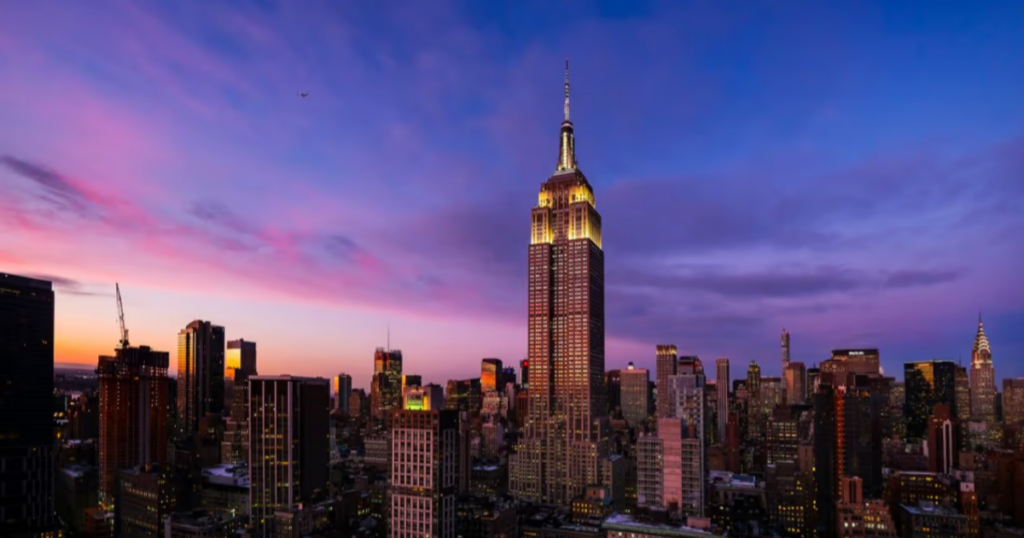
The Empire State Building is an iconic skyscraper located in New York City, United States. It is a cultural and architectural landmark, attracting millions of visitors each year.
Read More About The USA on Exploring the Best of America: A Guide to Must-Visit Tourist Destinations in the USA
Who built it?
The Empire State Building was designed by architects William F. Lamb and Shreve, Lamb and Harmon, and was constructed by the Starrett Brothers and Eken.
Why was it built?
The Empire State Building was built during the Great Depression as a symbol of hope and optimism, showcasing the power and ingenuity of American engineering and industry. It was also built to serve as a commercial and office space for various businesses.
Location:
The Empire State Building is located in the heart of Manhattan, New York City, in the United States.
Visiting Hours and Ticket Fees:
The Empire State Building is open to visitors every day from 8:00am to 2:00am. Tickets can be purchased in advance or on-site, with prices varying depending on the type of ticket and access level. The general admission ticket starts at $45 per adult, with additional fees for optional upgrades and experiences such as the observation deck and express pass.
Writer”s Opinion
If you are looking for a pocket-friendly and easily accessible landmark to visit, I would recommend the Golden Gate Bridge in San Francisco, California, USA. The bridge can be easily accessed by public transportation or by car, and there is no admission fee to walk or bike across it. Additionally, the city of San Francisco has a lot of affordable accommodation options and a variety of things to see and do, making it a great budget-friendly destination.
Table of Contents
Also Read

